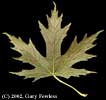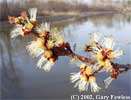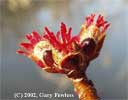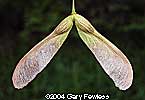
Trees of Wisconsin
| Acer
saccharinum L. silver maple Family: Aceraceae |
||||||||||||||||
|
||||||||||||||||
|
The leaves of Acer saccharinum are simple, opposite and lobed and the undersurface may be conspicuously lighter in color than the upper surface. The leaves are the most deeply lobed of any of our maples. Buds are red and black and are indistinguishable from those of Acer rubrum. Some individual trees are difficult to place as either A. saccharinum or A. rubrum in the absence of flowers or fruit and the two species may hybridize in some cases. Except for the earliest individuals of Skunk Cabbage (Symplocarpus foetidus), Acer saccharinum is the earliest flowering plant in our area, dispersing pollen in March in most years in the Green Bay area. The flowers on any given tree all open within a few days and the flowering period for any given locality may be very short. Seeds are produced by early June and drop soon thereafter. They are very sensitive to drying out and if they don't germinate within a couple of weeks after they fall they generally will not germinate at all. Acer saccharinum is very fast growing and after a couple of years to get their root system well established they can gain up to 5 feet in height in a single year. If Acer saccharinum trees are damaged, as they commonly are along rivers by floating ice and debris during spring floods, they may form distinctive multiple-stemmed clumps. Acer saccharinum ranges across much of the eastern U.S.A. from Minnesota to Louisiana and east to New Brunswick, Maine and Georgia. It is widely distributed in Wisconsin, more abundant in the south, and largely found along streams and lakes and in deciduous swamps. It was also previously a common street tree (one of my favorites), but is less commonly planted in recent years. |
|







